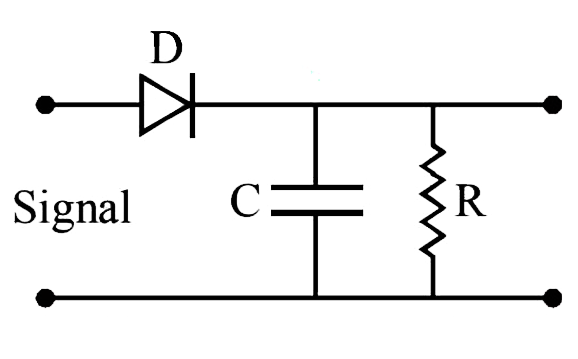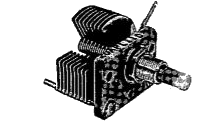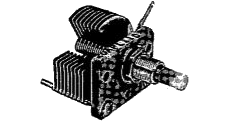The load on an Am diode detector consists of a resistance of 50KΩ in parallel with a capacitor of 0.001μF. Determine the maximum modulation index that the detector can handle without distortion when modulation frequency is (i) 1kHz (ii) 5kHz
Here RC and C are in parallel combination and phase difference between i1 and i2 is π2
i2+i21+i22
[VZm]2=[VRc]2+[VXc]2
Zm=1√1(Rc)2+1(Xc)2
Mmax=ZmRc
=1Rc√1(Rc)2+1(Xc)2
=1√1+(2πfCRc)2
For f=1kHz
Mmax=1√1+0.098696=0.945
For f=5kHz
Mmax=1√1+24674=0.537
Topper's Solved these Questions
- BOOK - NARAYNACHAPTER - COMMUNICATION SYSTEMEXERCISE - C.U.Q103videos
COMMUNICATION SYSTEM
- BOOK - NARAYNACHAPTER - COMMUNICATION SYSTEMEXERCISE - Level-I(C.W)16videos
COMMUNICATION SYSTEM
- BOOK - NARAYNACHAPTER - CAPACITANCEEXERCISE - Previous IIT-JEE16videos
CAPACITANCE
- BOOK - NARAYNACHAPTER - CURRENT ELECTRICITYEXERCISE - Level 643videos
CURRENT ELECTRICITY
Similar Questions
A message signal of frequency 20 KHz and peak voltage of 20 volts is used to modulate a carrier signal of frequency 2 MHz and peak voltage of 40 volts. Determine (i) modulation index, (ii) the side bands produced. Draw the corresponding frequency spectrum of amplitude modulated signal.
View SolutionA message signal of frequency 10 kHz and peak voltage 10 volt is used to modulate a carrier of frequency 0.5 MHz and peak voltage 100 volt. Determine (i) modulation index (ii) the side bands produced.
View Solution
Knowledge Check
- Question 1 - Select One
The modulation index of an FM signal is 1.5. The modulating frequency is 5 KHz. What is the maximum frequency deviation ?
AA. 5 KHzBB. 6 KHzCC. 7.5 KHzDD. 9 KHz - Question 2 - Select One
A diode detector is used to detect an amplitudennodulated wave of 60% modulation by using a condence of capacity 250 picodarad in parallel with a load resistance 100 kilo obm find the maximum modulated which could be find the maximum modalated frequency which could be detected by it
 A10.62MHzB10.62kHzC5.31MHzD5.31kHz
A10.62MHzB10.62kHzC5.31MHzD5.31kHz - Question 3 - Select One
A carrier frequency of 1 MHz and peak value of 10 V is amplitude modulated with a signal frequency of 10 KHz with peak value of 0.5 V. What are the values of the modulation index and the side band frequencies ?
A0.05 and 1±0.010 MHzB0.5 and 1 ± 0.010 MHzC0.05 and 1± 0.005 MHzD0.5 and 1 ± 0.005 MHz
In a simple AM transmitter, the tuned circuit uses a coil of 40μH and a shunt capacitor of 1 n F. If the oscillator output is modulated by audio frequencies upto 5kHz, what is the frequency range occupied by side bands?
View SolutionRead the following text and answer the following questions on the basis of the same:
Tuning a radio set: In essence the simplest tuned radio frequency receiver is a simple crystal set. Desired frequency is tuned by a tuned coil/ capacitor combination, and then the signal is presented to a simple crystal or diode detector where the amplitude modulated signal, is demodulated. This is then passed straight to the headphones or speaker. In radio set there is an LC oscillator comprising of a variable capacitor (or sometimes a variable coupling coil), with a knob on the front panel to tune the receiver.
Capacitor used in old radio sets is gang capacitor. It consists of two sets of parallel circular plates one of which can rotate manually by means of a knob. The rotation causes overlapping areas of plates to change, thus changing its capacitance. Air gap between plates acts as dielectric.
The capacitor has to be tuned in tandem corresponding to the frequency of a station so that the LC combination of the radio set resonates at the frequency of the desired station.

When capacitive reactance (XC) is equal to the inductive reactance (XL), then the resonance occurs 1 and the resonant frequency is given by ω0=1√LC current amplitude becomes maximum at the resonant frequency. It is important to note that resonance phenomenon is exhibited by a circuit only if both L and C are present in the circuit. Only then do the voltages across L and C cancel each other (both being out of phase) and the Current amplitude is open, VmR, the total source voltage appearing across R.
This means that we cannot have resonance in a RL or RC circuit.
Capacitor used in radio set for tuning is a:View SolutionRead the following text and answer the following questions on the basis of the same:
Tuning a radio set: In essence the simplest tuned radio frequency receiver is a simple crystal set. Desired frequency is tuned by a tuned coil/ capacitor combination, and then the signal is presented to a simple crystal or diode detector where the amplitude modulated signal, is demodulated. This is then passed straight to the headphones or speaker. In radio set there is an LC oscillator comprising of a variable capacitor (or sometimes a variable coupling coil), with a knob on the front panel to tune the receiver.
Capacitor used in old radio sets is gang capacitor. It consists of two sets of parallel circular plates one of which can rotate manually by means of a knob. The rotation causes overlapping areas of plates to change, thus changing its capacitance. Air gap between plates acts as dielectric.
The capacitor has to be tuned in tandem corresponding to the frequency of a station so that the LC combination of the radio set resonates at the frequency of the desired station.

When capacitive reactance (XC) is equal to the inductive reactance (XL), then the resonance occurs 1 and the resonant frequency is given by ω0=1√LC current amplitude becomes maximum at the resonant frequency. It is important to note that resonance phenomenon is exhibited by a circuit only if both L and C are present in the circuit. Only then do the voltages across L and C cancel each other (both being out of phase) and the Current amplitude is open, VmR, the total source voltage appearing across R.
This means that we cannot have resonance in a RL or RC circuit.
Resonance occurs only when:View SolutionRead the following text and answer the following questions on the basis of the same:
Tuning a radio set: In essence the simplest tuned radio frequency receiver is a simple crystal set. Desired frequency is tuned by a tuned coil/ capacitor combination, and then the signal is presented to a simple crystal or diode detector where the amplitude modulated signal, is demodulated. This is then passed straight to the headphones or speaker. In radio set there is an LC oscillator comprising of a variable capacitor (or sometimes a variable coupling coil), with a knob on the front panel to tune the receiver.
Capacitor used in old radio sets is gang capacitor. It consists of two sets of parallel circular plates one of which can rotate manually by means of a knob. The rotation causes overlapping areas of plates to change, thus changing its capacitance. Air gap between plates acts as dielectric.
The capacitor has to be tuned in tandem corresponding to the frequency of a station so that the LC combination of the radio set resonates at the frequency of the desired station.

When capacitive reactance (XC) is equal to the inductive reactance (XL), then the resonance occurs 1 and the resonant frequency is given by ω0=1√LC current amplitude becomes maximum at the resonant frequency. It is important to note that resonance phenomenon is exhibited by a circuit only if both L and C are present in the circuit. Only then do the voltages across L and C cancel each other (both being out of phase) and the Current amplitude is open, VmR, the total source voltage appearing across R.
This means that we cannot have resonance in a RL or RC circuit.
Resonance frequency is equal to:View SolutionRead the following text and answer the following questions on the basis of the same:
Tuning a radio set: In essence the simplest tuned radio frequency receiver is a simple crystal set. Desired frequency is tuned by a tuned coil/ capacitor combination, and then the signal is presented to a simple crystal or diode detector where the amplitude modulated signal, is demodulated. This is then passed straight to the headphones or speaker. In radio set there is an LC oscillator comprising of a variable capacitor (or sometimes a variable coupling coil), with a knob on the front panel to tune the receiver.
Capacitor used in old radio sets is gang capacitor. It consists of two sets of parallel circular plates one of which can rotate manually by means of a knob. The rotation causes overlapping areas of plates to change, thus changing its capacitance. Air gap between plates acts as dielectric.
The capacitor has to be tuned in tandem corresponding to the frequency of a station so that the LC combination of the radio set resonates at the frequency of the desired station.

When capacitive reactance (XC) is equal to the inductive reactance (XL), then the resonance occurs 1 and the resonant frequency is given by ω0=1√LC current amplitude becomes maximum at the resonant frequency. It is important to note that resonance phenomenon is exhibited by a circuit only if both L and C are present in the circuit. Only then do the voltages across L and C cancel each other (both being out of phase) and the Current amplitude is open, VmR, the total source voltage appearing across R.
This means that we cannot have resonance in a RL or RC circuit.
Resonance may occur in:View Solution

